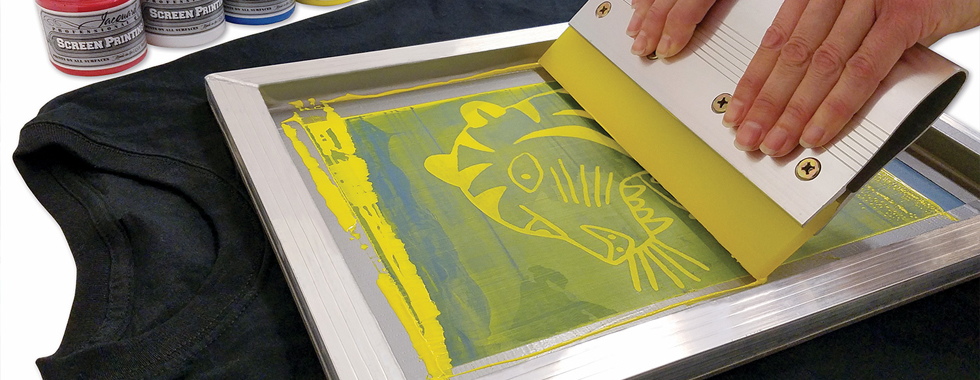The Essential Overview to Understanding Screen Printing and Its Versatile Makes use of
Screen printing has an abundant history that goes back to old times, progressing right into an innovative method made use of across various sectors today. This overview checks out the ins and outs of the screen printing procedure, describing its applications in fashion, home, and advertising decoration - 10:9 Design LLC Company. Recognizing these principles can open innovative possibility for both industrial and imaginative jobs. The adhering to areas will certainly expose essential pointers and techniques to enhance one's screen printing undertakings
The History of Screen Printing
Screen printing has roots that trace back centuries, its advancement mirrors the imaginative and technical advancements of various societies. Coming from ancient China, the strategy was initially made use of for embellishing fabrics and later spread to Japan, where it ended up being indispensable to Ukiyo-e woodblock printing. The technique changed to Europe in the 18th century, where it got popularity among artisans and commercial printers. The invention of picture solution in the 20th century reinvented screen printing, enabling even more detailed styles and greater effectiveness. Musicians like Andy Warhol even more pushed its appeal, using the medium to produce renowned works that mixed commercialism and art. By the late 20th century, screen printing had actually established itself as a functional strategy, utilized in style, advertising, and great art. Today, it continues to evolve, incorporating digital technology and increasing its applications throughout numerous sectors.
The Screen Printing Refine Explained
Screen printing transforms imaginative visions into tangible styles with a series of exact actions. Originally, a picture is created and after that moved onto a screen, typically made of fine mesh fabric stretched over a frame. A light-sensitive emulsion is put on the screen, which is exposed to light, solidifying in areas not covered by the photo. After washing out the unhardened emulsion, a pattern is formed.
Next off, the screen is put over the substratum, whether it be material, paper, or an additional material. Ink is after that pushed via the open areas of the pattern using a squeegee, depositing the design onto the substrate below. This process can be duplicated for multiple colors, requiring separate displays for each and every hue. The published thing is healed using heat to ensure the ink sticks effectively, resulting in a long lasting, lively layout prepared for usage.
Sorts Of Screen Printing Techniques

Furthermore, specialty methods, such as discharge screen printing, remove dye from the textile to create softer prints, while aluminum foil screen printing uses metallic aluminum foil to achieve a glossy finish (10:9 Design Texas). Each strategy offers unique attributes, dealing with numerous creative demands and local sign printing production scales, inevitably expanding the possibilities within the screen printing domain
Applications of Screen Printing in Numerous Industries

In addition, the signs and advertising markets utilize screen printing for creating distinctive displays and banners. This technique permits for bold colors and complex layouts that capture attention. In electronics, screen printing is utilized for using conductive inks to he has a good point motherboard, important for element links. The home décor market embraces screen printing to create distinct layouts on textiles and wall art. Generally, screen printing acts as a vital device throughout diverse areas, boosting items with individualized and aesthetically enticing graphics.
Tips for Effective Screen Printing Projects
While undertaking a screen printing task, mindful attention to detail can significantly improve the last result. Initially, picking high-quality materials is vital; this includes the screen, inks, and substratums. Making use of proper mesh counts can affect ink deposition and information resolution. Prep work is just as crucial; thorough cleaning of screens and correct direct exposure times assure crisp prints.
Next off, precise enrollment is crucial for multi-color prints. Using positioning tools can aid accomplish precise layering. Additionally, screening prints on scrap materials before production aids determine potential concerns without losing resources.

Often Asked Inquiries
What Products Are Finest for Screen Printing on Textile?
Cotton and polyester blends are ideal for screen printing on fabric because of their sturdiness and ink absorption. Furthermore, specialty textiles like silk or canvas can create distinct appearances and surfaces, improving the overall layout top quality.
Exactly how Do I Clean and Maintain Screen Printing Equipment?
To keep and clean up screen printing devices, one ought to routinely wash displays with ideal solvents, evaluate squeegees for wear, lube moving components, and store all items in a completely dry, dust-free setting to prolong their lifespan.
What Are the Ecological Effects of Screen Printing?
Screen printing can have significant ecological influences, including chemical waste from inks and solvents, water use during cleansing processes, and energy usage. Eco-friendly materials and lasting techniques are necessary for reducing these adverse results.
Can Screen Printing Be Done in your home Efficiently?
Screen printing can be effectively done at home with the ideal materials and methods. Hobbyists can develop high quality prints, though success relies on their skill degree, tools, and understanding of the procedure included.
What Are the Expenses Connected With Beginning a Display Printing Organization?

Beginning a screen printing service includes prices for equipment, products, and office. First expenses generally vary from a couple of hundred to numerous thousand dollars, depending on the scale, high quality of equipment, and wanted production capability.
Screen printing has an abundant background that dates back to old times, advancing right into a sophisticated technique made use of throughout numerous markets today. Another strategy, rotary screen printing, employs cylindrical screens, helping with continual printing on textile rolls, thereby enhancing effectiveness for massive productions. Additionally, specialty techniques, such as discharge screen printing, remove dye from the fabric to create softer prints, while foil screen printing applies metal aluminum foil to achieve a shiny finish. In the fashion field, screen printing is extensively made use of to create vibrant designs on garments, making it possible for brand names to showcase their distinct styles. Cotton and polyester blends are excellent for screen printing on fabric due to their resilience and ink absorption.